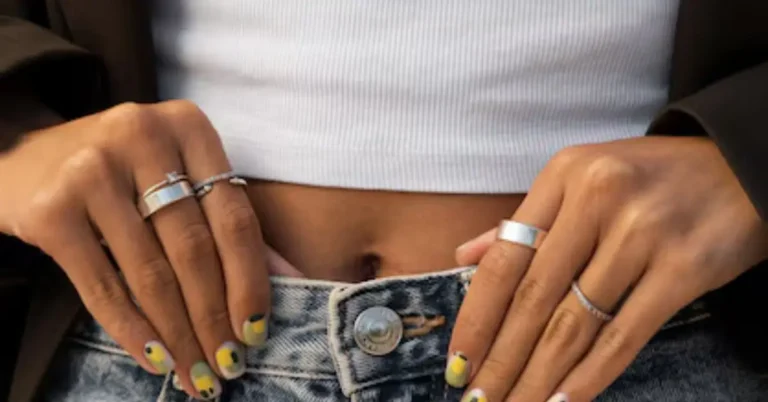Belly button piercings, also known as navel piercings, have been a popular form of body art for decades. This unique form of expression has captured the interest of many, especially within the younger demographic. But beyond the aesthetics, getting a belly button piercing involves a series of decisions that should not be taken lightly. From the cost of the procedure to the care required to maintain it, this comprehensive guide will walk you through everything you need to know about belly button piercings.
History and Cultural Significance
Belly button piercings are not just a modern trend. Body piercings, in general, have been practiced across various cultures for thousands of years. While navel piercings don’t have the same ancient roots as some other types of body piercings (like ear or nose piercings), they have been associated with various cultural meanings.
In ancient Egypt, for instance, body piercings, including navel piercings, were symbols of wealth and status. The Pharaohs and other high-ranking individuals adorned their bodies with jewelry to signify their power and divinity. While there is no conclusive historical evidence that belly button piercings were common, the association between navel jewelry and the elite class is well-documented in Egyptian history.
Fast forward to the 20th century, belly button piercings became popular in the West during the 1990s, largely due to celebrities and models who began sporting them in fashion magazines, music videos, and on the runway. This trend quickly took off and became a staple of youth and pop culture, symbolizing freedom, individuality, and a bit of rebelliousness.
Cost of Belly Button Piercing
One of the first questions many people have when considering a belly button piercing is, “How much will it cost?” The price of a belly button piercing can vary significantly depending on several factors:
- Location: Where you live can have a big impact on the cost. In major cities or more affluent areas, prices tend to be higher due to the higher cost of living and the demand for body modifications. In contrast, smaller towns or less urbanized areas may offer more affordable options.
- Piercing Studio: The reputation and quality of the piercing studio also play a significant role in determining the cost. Well-known, reputable studios with highly experienced piercers may charge more, but they often provide a safer and more professional experience. On the other hand, less established studios might offer cheaper rates, but this could come with a higher risk of complications or subpar service.
- Jewelry Choice: The type of jewelry you choose for your initial piercing can also affect the cost. Basic jewelry, usually made of surgical steel, is often included in the base price of the piercing. However, if you opt for jewelry made of more expensive materials, like titanium, gold, or with decorative gems, you can expect to pay more.
- Aftercare Products: While not always included in the initial piercing cost, aftercare products such as saline solution, antiseptic sprays, and healing balms are essential for proper healing and maintenance of your new piercing. These can add to the overall expense.
On average, you can expect to pay anywhere from $30 to $100 for a belly button piercing. In some high-end studios, the cost might go up to $150 or more, especially if you choose premium jewelry.
The Piercing Process
Understanding the piercing process can help alleviate some of the anxiety and uncertainty that may come with getting your navel pierced.
Consultation
Before getting pierced, you should have a consultation with your chosen piercer. During this consultation, you will discuss your expectations, any concerns you might have, and your overall health. It’s important to disclose any medical conditions, allergies, or if you’re taking any medications, as these can affect the healing process or your ability to get pierced safely.
Choosing the Jewelry
Your piercer will help you choose the appropriate jewelry for your piercing. The jewelry should be hypoallergenic and designed for initial piercings to minimize the risk of irritation or infection. Common materials include surgical steel, titanium, and niobium. The jewelry should also be appropriately sized to accommodate any swelling that may occur during the healing process.
The Piercing Procedure
On the day of the piercing, the piercer will start by cleaning the area around your navel with an antiseptic solution to reduce the risk of infection. They will then mark the entry and exit points of the piercing with a sterile marker to ensure proper placement. You should confirm that you are happy with the placement before proceeding.
The actual piercing is done using a hollow needle, which is designed to remove a small piece of tissue to create space for the jewelry. The needle is typically inserted at a slight angle to ensure that the jewelry sits comfortably and correctly. After the needle has been inserted, the jewelry is immediately placed into the new piercing.
The process is relatively quick, often taking only a few minutes, but the sensation can vary from person to person. Some people describe it as a sharp pinch, while others might feel more discomfort. Your piercer will likely give you a moment to compose yourself and provide aftercare instructions.
Pain and Healing
Pain is a subjective experience, and the level of discomfort associated with a belly button piercing can vary from person to person. Most people report that the pain is brief and tolerable, similar to a quick pinch. However, the area around the navel is sensitive, so it’s normal to experience some tenderness and soreness for a few days after the procedure.
Healing Time
The healing time for a belly button piercing can vary depending on several factors, including your overall health, aftercare practices, and whether or not there are any complications. On average, a navel piercing can take anywhere from 6 to 12 months to fully heal. During this time, it’s important to follow your piercer’s aftercare instructions carefully to ensure proper healing.
Signs of Healing
During the healing process, it’s normal to experience some redness, swelling, and minor discomfort around the piercing site. You may also notice a small amount of discharge, which is a natural part of the healing process as your body expels any dead cells or debris from the wound. However, there are certain signs that may indicate an infection or other complications, including:
- Increased Pain or Swelling: If the pain or swelling becomes worse rather than better over time, this could be a sign of infection.
- Foul-Smelling Discharge: While some discharge is normal, it should not have a foul odor. This could be a sign of infection.
- Prolonged Redness or Heat: If the area around the piercing remains red or hot to the touch after the initial few days, this could indicate an infection.
If you experience any of these symptoms, it’s important to seek medical attention or contact your piercer for advice.
Aftercare
Proper aftercare is crucial to ensure that your belly button piercing heals correctly and doesn’t become infected. Here are some general aftercare tips:
- Cleaning: Clean the piercing site twice a day with a saline solution or a piercing aftercare spray. Avoid using alcohol, hydrogen peroxide, or harsh soaps, as these can irritate the piercing and delay healing.
- Avoid Touching: Try to avoid touching your piercing as much as possible, especially with dirty hands. If you need to touch it, make sure your hands are clean.
- Avoid Tight Clothing: Wearing tight clothing that rubs against your piercing can cause irritation and prolong the healing process. Opt for loose-fitting clothing until the piercing is fully healed.
- Be Careful with Physical Activity: Activities that involve a lot of bending or stretching can put pressure on your piercing and delay healing. It’s also important to avoid swimming in pools, hot tubs, or natural bodies of water, as these can introduce bacteria to the piercing site.
- Monitor for Signs of Infection: Keep an eye on your piercing for any signs of infection. If you notice increased pain, redness, swelling, or discharge, contact your piercer or a healthcare professional immediately.
Jewelry Options
One of the fun aspects of getting a belly button piercing is the wide variety of jewelry options available once your piercing has healed. Here are some common types of belly button jewelry:
- Barbells: Curved barbells are the most common type of jewelry used in belly button piercings. They consist of a curved bar with a ball or gem on each end.
- Rings: Captive bead rings or seamless rings are also popular options. These rings encircle the piercing and are held in place by a small bead or segment.
- Dangles: Dangle jewelry features decorative elements that hang down from the piercing, adding a bit of flair. These are often chosen for special occasions or as a statement piece.
- Non-Dangle Jewelry: If you prefer something more understated, non-dangle jewelry with a simple gem or charm is a great option.
When choosing jewelry, it’s important to consider the material. Hypoallergenic materials like titanium, surgical steel, and niobium are ideal for minimizing the risk of irritation or allergic reactions.
Potential Risks and Complications
As with any body modification, there are potential risks and complications associated with belly button piercings. Being aware of these risks can help you make an informed decision and take the necessary precautions.
Infection
Infection is the most common complication associated with belly button piercings. This can occur if bacteria enter the piercing site, often due to improper aftercare or exposure to unclean environments. Signs of infection include increased redness, swelling, pain, and a foul-smelling discharge.
Migration and Rejection
In some cases, the body may treat the jewelry as a foreign object and attempt to push it out, a process known as migration or rejection. This can cause the piercing to move from its original position or even come out completely. Migration and rejection are more common with surface piercings, but they can happen with belly button piercings if the jewelry is too shallow or if the body simply reacts poorly to the piercing.
Allergic Reactions
Some people may experience an allergic reaction to the metal in the jewelry, especially if it contains nickel. Symptoms of an allergic reaction include itching, redness, and swelling. If you have a known metal allergy, make sure to choose hypoallergenic jewelry made from materials like titanium or niobium.
Keloids and Hypertrophic Scarring
Keloids and hypertrophic scars are types of raised scars that can form around the piercing site. Keloids are more common in people with a genetic predisposition, while hypertrophic scars can develop due to irritation or improper aftercare. These scars can be difficult to treat and may require medical intervention.
Conclusion
Belly button piercings are a popular and stylish way to express individuality and enhance your body’s natural beauty. However, like any form of body modification, they come with certain risks and responsibilities. By understanding the cost, process, and aftercare involved, you can make an informed decision and enjoy your belly button piercing with confidence.
If you’re considering getting a belly button piercing, take the time to research reputable studios, understand the healing process, and commit to proper aftercare. By doing so, you’ll be able to enjoy your new piercing without unnecessary complications and ensure that it remains a beautiful and lasting part of your personal style.

